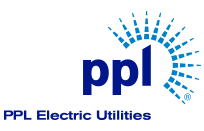PPL Website Teacher’s Guide
This teacher’s guide will help you use the e-SMARTkids site to educate your students about energy and electricity.
We’ve included an overview of the site’s structure and content, and suggestions for enhancing students’ learning through classroom discussion and further exploration.
Site Overview
The e-SMARTkids site uses games, core curriculum science content, and activities to teach students and their families about electrical safety, energy science, and the principles of energy efficiency. The site is geared to a range of interests and reading levels and can be used by students in elementary, middle, and high school. Non-readers will need adult assistance to play the games.
This site features an extensive section for students, an informational section for teachers (you’re in that section now), and a brief section for parents.
Kids Section
This tab includes six components:
1. Get SMART! Content Sections. These sections cover a variety of standards-related core content about electrical safety, energy science, and energy efficiency.
- Electrical Safety-SMART: Discusses principles of electricity science and strategies for indoor and outdoor electrical safety, as well as featuring testimonials from electrical accident survivors. It also includes a section on Energy Efficiency in the Tell Me More section.
- Energy-SMART: Teaches the basics of energy science, renewable energy, energy efficiency practices, and how to care for the environment.
- Energy Science-SMART: Covers more advanced energy science concepts appropriate for middle and high school, including lots of experiments and activities, and sections on alternative energy, electric vehicles, energy careers, and ideas for research.
2. Activity Pages. Printable puzzle and handouts geared toward grades K-3 that reinforce electrical safety, renewable energy, and energy conservation concepts and practices.
3. Ask an Expert. Features questions (from real students) and answers that convey interesting facts about energy and electrical safety. These are changed periodically in response to questions submitted by students.
4. Games. Interactive games that capture kids’ interest while conveying information about electrical safety, energy efficiency, and renewable energy, giving students an opportunity to put principles learned in these areas into practice.
- It’s Not Trivial: A fun quiz-show style game that serves as a brief review of concepts introduced in the Energy Science-SMART website section.
- The Voltinator: Promotes student understanding of voltage and how it propels electrons between atoms in a circuit to power electric appliances.
- Shock Blocker: Alerts students to the dangers of water and electrical shock hazards.
- Find the Hidden Dangers: Illustrates numerous dangerous situations around electricity outdoors, and explains what to do about them.
5. Home Inspections. Printable checklists on electrical safety and energy efficiency practices that students can do with their families at home.
6. Call Before You Dig. This section introduces students to the 811 system, designed to help people dig safely when doing projects around their home so as not to disturb underground utility lines.
Teachers Section
This tab includes three components:
1. Classroom Resources. Get SMART! Curriculum Materials include this website teacher’s guide; experiments and hands-on activities for each of the three Get SMART! sections of the site, as well as printable worksheets. The worksheets assess comprehension of the core messages introduced in the Get SMART! sections: electrical safety, energy efficiency, and energy science.
2. Energy Glossary. Contains energy vocabulary words found on this site that may be unfamiliar to students.
3. Home Inspections. Printable checklists on electrical safety and energy efficiency practices that students can do with their families at home, and an energy efficiency inspection for school as well.
Parents Section
This tab features useful energy information for parents, including tips on safe digging, an energy glossary, and home electrical safety and energy efficiency inspections. It also clarifies the privacy policy of this website.
Enhancing Student Learning
You can reinforce what students learn on this site by reviewing the key objectives for each component and conducting classroom discussions about them. Here are some suggestions.
Core Content Worksheets, Experiments, and Activities
For each of the three content sections (Safety-SMART, Energy-SMART, and Energy Science-SMART) there is a student worksheet that tests students’ retention of core concepts. For hands-on learning to support these concepts, please see the Experiments and Activities component correlating to each section. All of these features are found in the Teachers section.
K-3 Activity Pages
Print these activity pages for younger students. The Energy Tip Cards make a great homework project and help students share conservation tips with their families.
Ask an Expert
Ask students to brainstorm their own questions about electrical safety and submit them on this page. Encourage them to revisit the site, as questions in this section are updated periodically.
Games
Some teachers find it useful to have students report back to the class what they learned after playing these games. Or you may wish to use the games as a fun reward or review of what’s been learned elsewhere on the site. Consider the following discussion ideas.
- The Voltinator
-
- Make sure your students review the “Reality Check” feature, which you can find when you click “Play Game” at the left, by the Power Meter. Here they will find a Build Your Own Circuit experiment, with some text about how circuits work.
- The Voltinator game shows a simple way that electrons flow from what to what? (From atom to atom.)
- When electrons flow from atom to atom in a circuit what happens? (Electric current is produced.)
- How do real life circuits differ from the circuit in this game? (In real life, electricity is produced at one place, then travels through a circuit, and returns to the starting place.)
- In the ‘build a circuit’ experiment, what is a battery a substitute for in the real-life making of electricity? (A power plant.)
- What role does the battery or the power plant serve in making electricity? (It is the power source.)
- Shock Blocker
-
- Kids will stop the lightning bolt from appearing three times in a row on the game board.
- It’s Not Trivial
-
- What electrical safety tips are discussed in this game? (Even low-voltage appliances can cause dangerous electric shock; stay away from pad-mounted transformers; use only battery-powered radios near a tub or pool; clean appliances only when they are unplugged, and keep them away from water.)
- What are some of the science concepts? (Electricity is carried by electrons; the flow of electrons from atom to atom through a conductor is an electric current; the nature of ground faults and circuits.)
- Name an energy-saving tip. (Turn off your computer when not using it.)
- What are some lightning safety tips? (Don’t open an umbrella when there’s lightning. If you cannot get into a house or other building during a lightning storm, stay inside a hardtop car with the windows closed.)
- Find the Hidden Dangers
-
- What are the dangers to avoid outdoors around electric power lines? (Putting ladders near them; stay away from a downed power line; don’t fly a kite near power lines; don’t climb trees near power lines; don’t get out of a car that has hit a power line unless there is immediate danger such as fire.)
- What are two unsafe things one could do outside that involve water and electricity? (Mowing the lawn when grass is wet; using an electric-powered radio while washing the car.)
- What are unsafe practices around substations and transformers? (Throwing objects near insulators is dangerous as the electricity goes down the power pole; transformers should never be tampered with; climbing a substation fence is dangerous and an adult should be called for help if a toy accidentally falls inside.) What should you do before starting a digging project in your yard? (Call your local utility locator service to make sure there are no underground lines buried nearby.)
Home Electrical Safety and Energy Inspections
Review the checklists with students in class, and then assign completion of these for homework. Ask students to report back for an in-class graphing activity. Chart the practices that most commonly appear under “Needs Fixing” (for Safety) or “Not Yet” (for Energy Efficiency). Have students postulate why these practices might be the ones least commonly engaged in, and then discuss what they can do about it.
Going Further
Use the following ideas to help your students take their understanding of electrical safety, energy efficiency, and energy science to the next level.
- Prepare a 3-minute presentation or skit for the class on potential dangers around electricity and how to remedy or prevent them.
- Create a poster showing the various types of renewable energy or various ways to help conserve resources at home.
- Create a radio commercial advocating practices and activities that one can do to help protect the environment.
- Come up with an interesting question about energy and electricity that is not answered on this website. Research the answer, and explain it with an in-class presentation.
- Create a quiz-show game using the Fantastic Facts questions at the end of each of the segments of the Energy Science-Smart section of this website. Find some questions of your own to add to the mix. Test your parents, older neighbors, and/or extended family to see who knows the most energy facts.
- Show this website to your parents, and then interview them as to what they learned about how energy works, how to be safe around electricity, or how to save energy. Report back to the class.

